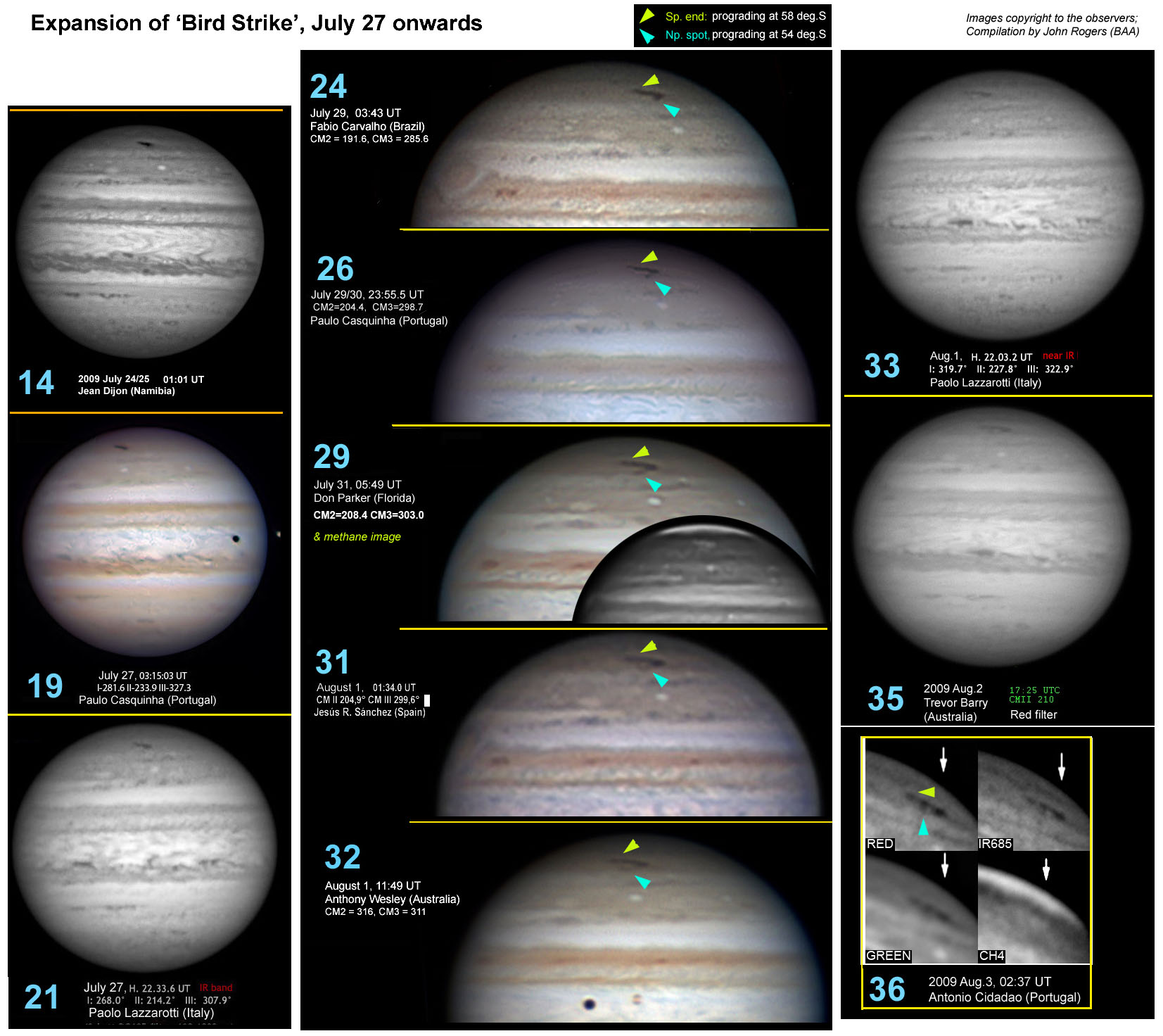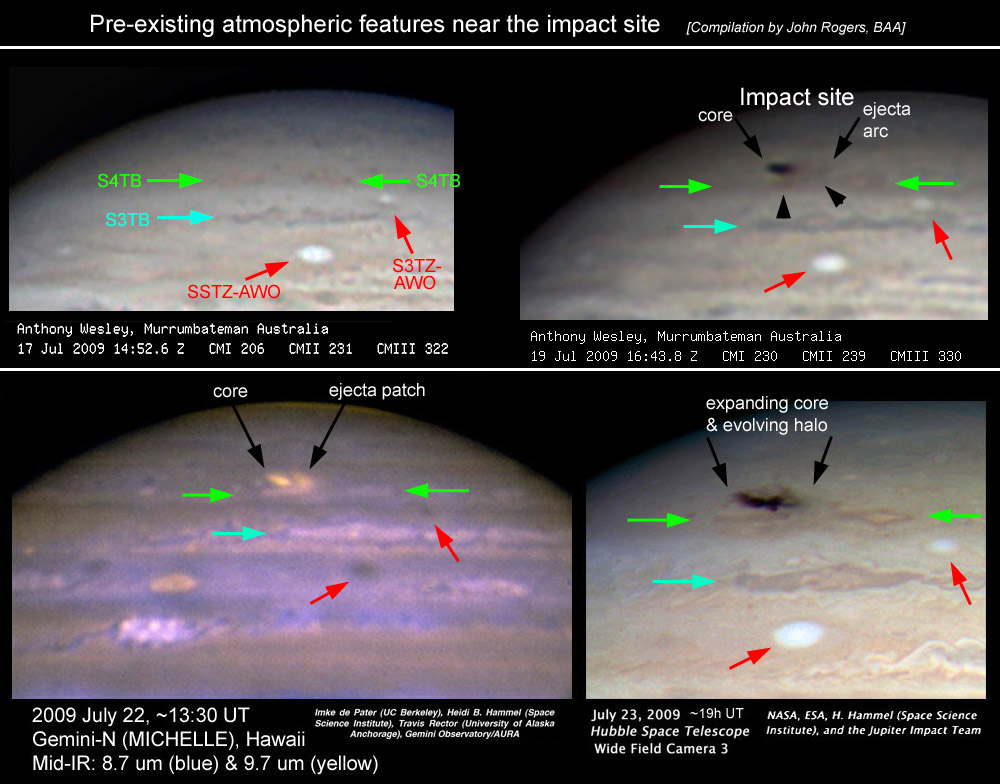| Summary of the Bird Strike evolution by John H.Rogers,E.Morales |
Observers have recently reported that the impact 'scar' has started to spread out rapidly. Here are two more compilations of some of the best images. One from July 17-23 (Anthony's, Gemini-N, and Hubble images) is labelled to indicate pre-existing atmospheric features. The other set, from July 27 onwards, shows the recent expansion. A set of images on every rotation from July 27 onwards has also been prepared, continuing the previous series, but as it's big, I'll just send it to anyone who asks.
The dark impact 'scar' is expected to have two components, as with the SL9 scars:
1) The nearly-black core, where the impactor exploded below the cloud-tops; the black smoke may be convecting upwards from below the clouds, as well as lying in the stratosphere.
2) A more extensive layer of smoke in the stratosphere, initially deposited from the ejecta 'splash-back'.
At the impact latitude of 57 deg.S, the cloud-top zonal wind speed is retrograde: DL2 = +12.2 deg/mth (DL3 = +20.2 deg/mth, -5.5 m/s: Cassini spacecraft data). So the impact scar might be predicted to drift with this rate, or closer to System 3, depending on the vertical wind profile. (It lies mid-way between prograding jets at 53 deg.S and 61 deg.S. No slow current is defined so far south.)
The JUPOS team have used the WinJUPOS program to measure the impact site and to plot maps of it in polar projections. (Thanks to Hans-Joerg Mettig for sending the data.) A chart of the expansion is attached.
The core of the site has remained almost stationary (initial L2 = 216, DL2 = -4 deg/mth; L3 = 307, DL3 = +4 deg/mth; July 19-27). It was initially oval, indicating the direction of impact, and elongated gradually to E and W:
(P. end, DL2 ~ -20 deg/mth; F. end, DL2 ~ +6 deg/mth).
> From July 29 onwards the expansion was more obvious, from both the N and S
edges. Observers including Raffaello Lena, Trevor Barry, and Anthony Wesley, noted the rapid change in shape. The N and S edges are now prograding while the darkest core is retrograding. These motions trace out the zonal winds as previously measured by spacecraft, except at the S edge where the motion may represent a rapid stratospheric flow.
In particular:
-- Nf. edge: a distinct dark spot detached and prograded rapidly at 54 deg.S, N of the main site. It is close to the prograding jet at 53 deg.S, and probably represents a cloud of smoke from the core which has been caught in this zonal wind.
-- Core: Now retrograding (still at 57 deg.S): Consistent with zonal wind.
-- Sp. edge: the site is elongating in the p. direction (Sp. end at 58 deg.S). The zonal speed at this latitude is close to zero, so the prograding drift may be special to the stratosphere, as was the case with the extended dark clouds around the SL9 impact sites. (In Don Parker's methane image on July 31, this Sp. streak is clearly at high altitude, while the northern spot is much less evident.)
Anthony Wesley, Clay Sherrod, and others have noted that the prograding streaks have curled around to enclose a light oval - possibly caught in the currents around a pre-existing oval - an appearance which seems to be confirmed by Trevor Barry and Antonio Cidadao on August 3. Alternatively, as Raffaello Lena suggested, this oval could be a transient hole between the independently drifting dark streaks. Any pre-existing circulation is not obvious to me in pre-impact or HST images, and bright spots adjacent to the impact site must be regarded with caution as they can be generated by the image processing.
The impact site was still nearly black up to August 1, but observers noted it was fainter on August 2 as it stretched out. This timecourse is very similar to that of medium-sized SL9 impact E (Impact July 17; 'black' core till Aug.2; from Aug.2, gradually faded as a dusky E-W streak within the growing 'impact belt'; last seen distinctly Sep.2.)
Near-IR images have been taken by many observers, and although I have not included many of them in these montages, because the impact site is not so dark in them, this actually makes them valuable for identifying the densest part of the impact site, presumably the deep core. Best wishes,
John Rogers, August 4.

John H. Rogers,Ph.D. Jupiter Section Director, [British Astronomical Association.]
ALPO-Japan Latest
Jupiter Section